Impact Analysis of Temperature and Humidity Conditions on Electrochemical Sensor Response in Ambient Air Quality Monitoring
Abstract
:1. Introduction
2. Experimental Methodology
2.1. Laboratory Tests
2.1.1. Standard Gas Generation
2.1.2. Sensor Test Apparatus
2.1.3. Reference Gas Instruments
2.1.4. Data Collection
2.2. Field Tests
2.3. Correction Model Development
3. Results and Discussion
3.1. Laboratory Evaluations
3.1.1. Linearity Test under Stable and Variable Conditions
3.1.2. Long Term Drift
3.1.3. Cross Interference
3.2. Evaluation of the Correction Models
3.3. Error Analysis
4. Conclusions
Acknowledgement
Author Contributions
Conflicts of Interest
References
- Pope, C.A.; Burnett, R.T.; Thun, M.J.; Calle, E.E.; Krewski, D.; Ito, K.; Thurston, G.D. Lung cancer, cardiopulmonary mortality, and long-term exposure to fine particulate air pollution. JAMA 2002, 287, 1132–1141. [Google Scholar] [CrossRef] [PubMed]
- Brunekreef, B.; Holgate, S.T. Air pollution and health. Lance 2002, 360, 1233–1242. [Google Scholar] [CrossRef]
- Manoli, E.; Voutsa, D.; Samara, C. Chemical characterization and source identification/apportionment of fine and coarse air particles in Thessaloniki, Greece. Atmos. Environ. 2002, 36, 949–961. [Google Scholar] [CrossRef]
- Volkamer, R.; Jimenez, J.L.; San Martini, F.; Dzepina, K.; Zhang, Q.; Salcedo, D.; Molina, L.T.; Worsnop, D.R.; Molina, M.J. Secondary organic aerosol formation from anthropogenic air pollution: Rapid and higher than expected. Geophys. Res. Lett. 2006, 33. [Google Scholar] [CrossRef]
- Colvile, R.N.; Hutchinson, E.J.; Mindell, J.; Warren, R. UCL discovery—The transport sector as a source of air pollution. Atmos. Environ. 2001, 35, 1537–1565. [Google Scholar] [CrossRef]
- Hedley, A.J.; McGhee, S.M.; Barron, B.; Chau, P.; Chau, J.; Thach, T.Q.; Wong, T.W.; Loh, C.; Wong, C.M. Air pollution: Costs and paths to a solution in Hong Kong—Understanding the connections among visibility, air pollution, and health costs in pursuit of accountability, environmental justice, and health protection. J. Toxicol. Environ. Health A 2008. [Google Scholar] [CrossRef] [PubMed]
- Zhong, L.; Louie, P.K.K.; Zheng, J.; Yuan, Z.; Yue, D.; Ho, J.W.K.; Lau, A.K.H. Science-policy interplay: Air quality management in the Pearl River Delta region and Hong Kong. Atmos. Environ. 2013. [Google Scholar] [CrossRef]
- Clemitshaw, K. A Review of Instrumentation and Measurement Techniques for Ground-Based and Airborne Field Studies of Gas-Phase Tropospheric Chemistry. Crit. Rev. Environ. Sci. Technol. 2004. [Google Scholar] [CrossRef]
- Analytical Techniques for Atmospheric Measurement; Heard, D.E. (Ed.) Wiley: Hoboken, NJ, USA, 2007; ISBN 1405123575. [Google Scholar]
- Piedrahita, R.; Xiang, Y.; Masson, N.; Ortega, J.; Collier, A.; Jiang, Y.; Li, K.; Dick, R.P.; Lv, Q.; Hannigan, M.; Shang, L. The next generation of low-cost personal air quality sensors for quantitative exposure monitoring. Atmos. Meas. Tech. 2014. [Google Scholar] [CrossRef] [Green Version]
- Kumar, P.; Morawska, L.; Martani, C.; Biskos, G.; Neophytou, M.; Di Sabatino, S.; Bell, M.; Norford, L.; Britter, R. The rise of low-cost sensing for managing air pollution in cities. Environ. Int. 2015, 75, 199–205. [Google Scholar] [CrossRef] [PubMed] [Green Version]
- Yi, W.; Lo, K.; Mak, T.; Leung, K.; Leung, Y.; Meng, M. A Survey of Wireless Sensor Network Based Air Pollution Monitoring Systems. Sensors 2015, 15, 31392–31427. [Google Scholar] [CrossRef] [PubMed]
- Jiao, W.; Hagler, G.; Williams, R.; Sharpe, R.; Brown, R.; Garver, D.; Judge, R.; Caudill, M.; Rickard, J.; Davis, M.; et al. Community Air Sensor Network (CAIRSENSE) project: Evaluation of low-cost sensor performance in a suburban environment in the southeastern United States. Atmos. Meas. Tech. Discuss. 2016, 9, 5281–5292. [Google Scholar] [CrossRef]
- Spinelle, L.; Gerboles, M.; Villani, M.G.; Aleixandre, M.; Bonavitacola, F. Field calibration of a cluster of low-cost available sensors for air quality monitoring. Part A: Ozone and nitrogen dioxide. Sens. Actuators B Chem. 2015, 215, 249–257. [Google Scholar] [CrossRef]
- Spinelle, L.; Gerboles, M.; Villani, M.G.; Aleixandre, M.; Bonavitacola, F. Field calibration of a cluster of low-cost commercially available sensors for air quality monitoring. Part B: NO, CO and CO2. Sens. Actuators B Chem. 2017. [Google Scholar] [CrossRef]
- Kim, J.Y.; Chu, C.H.; Shin, S.M. ISSAQ: An Integrated Sensing Systems for Real-Time Indoor Air Quality Monitoring. IEEE Sens. J. 2014. [Google Scholar] [CrossRef]
- Snyder, E.G.; Watkins, T.H.; Solomon, P.A.; Thoma, E.D.; Williams, R.W.; Hagler, G.S.W.; Shelow, D.; Hindin, D.A.; Kilaru, V.J.; Preuss, P.W. The changing paradigm of air pollution monitoring. Environ. Sci. Technol. 2013. [Google Scholar] [CrossRef] [PubMed]
- Aleixandre, M.; Gerboles, M. Review of small commercial sensors for indicative monitoring of ambient gas. Chem. Eng. Trans. 2012, 30. [Google Scholar] [CrossRef]
- Whitenett, G.; Stewart, G.; Atherton, K.; Culshaw, B.; Johnstone, W. Optical fibre instrumentation for environmental monitoring applications. J. Opt. A Pure Appl. Opt. 2003. [Google Scholar] [CrossRef]
- Fine, G.F.; Cavanagh, L.M.; Afonja, A.; Binions, R. Metal oxide semi-conductor gas sensors in environmental monitoring. Sensors 2010, 10, 5469–5502. [Google Scholar] [CrossRef] [PubMed]
- Mead, M.I.; Popoola, O.A.M.; Stewart, G.B.; Landshoff, P.; Calleja, M.; Hayes, M.; Baldovi, J.J.; McLeod, M.W.; Hodgson, T.F.; Dicks, J.; et al. The use of electrochemical sensors for monitoring urban air quality in low-cost, high-density networks. Atmos. Environ. 2013. [Google Scholar] [CrossRef]
- Lin, C.; Gillespie, J.; Schuder, M.D.; Duberstein, W.; Beverland, I.J.; Heal, M.R. Evaluation and calibration of Aeroqual series 500 portable gas sensors for accurate measurement of ambient ozone and nitrogen dioxide. Atmos. Environ. 2015. [Google Scholar] [CrossRef] [Green Version]
- EuNetAir. Available online: http://www.eunetair.it/ (accessed on 2 January 2018).
- Borrego, C.; Costa, A.M.; Ginja, J.; Amorim, M.; Coutinho, M.; Karatzas, K.; Sioumis, T.; Katsifarakis, N.; Konstantinidis, K.; De Vito, S.; et al. Assessment of air quality microsensors versus reference methods: The EuNetAir joint exercise. Atmos. Environ. 2016, 147, 246–263. [Google Scholar] [CrossRef]
- Heimann, I.; Bright, V.B.; McLeod, M.W.; Mead, M.I.; Popoola, O.A.M.; Stewart, G.B.; Jones, R.L. Source attribution of air pollution by spatial scale separation using high spatial density networks of low cost air quality sensors. Atmos. Environ. 2015. [Google Scholar] [CrossRef]
- Castell, N.; Kobernus, M.; Liu, H.Y.; Schneider, P.; Lahoz, W.; Berre, A.J.; Noll, J. Mobile technologies and services for environmental monitoring: The Citi-Sense-MOB approach. Urban Clim. 2015, 14, 370–382. [Google Scholar] [CrossRef]
- Roberts, T.J.; Braban, C.F.; Oppenheimer, C.; Martin, R.S.; Freshwater, R.A.; Dawson, D.H.; Griffiths, P.T.; Cox, R.A.; Saffell, J.R.; Jones, R.L. Electrochemical sensing of volcanic gases. Chem. Geol. 2012. [Google Scholar] [CrossRef]
- Roberts, T.J.; Saffell, J.R.; Oppenheimer, C.; Lurton, T. Electrochemical sensors applied to pollution monitoring: Measurement error and gas ratio bias—A volcano plume case study. J. Volcanol. Geotherm. Res. 2014. [Google Scholar] [CrossRef]
- Alphasense. Available online: http://www.alphasense.com/WEB1213/wp-content/uploads/2013/07/AAN_104.pdf (accessed on 2 January 2018).
- Dai, H.; Gong, L.; Xu, G.; Zhang, S.; Lu, S.; Jiang, Y.; Lin, Y.; Guo, L.; Chen, G. An electrochemical sensing platform structured with carbon nanohorns for detecting some food borne contaminants. Electrochim. Acta 2013. [Google Scholar] [CrossRef]
- Hitchman, M.L.; Cade, N.J.; Kim, G.T.; Hedley, N.J.M. Study of the Factors Affecting Mass Transport in Electrochemical Gas Sensors. Analyst 1997. [Google Scholar] [CrossRef]
- White, R.M.; Paprotny, I.; Doering, F.; Cascio, W.E.; Solomon, P.A.; Gundel, L.A. EM: Air and Waste Management Association’s Magazine for Environmental Managers; Air & Waste Management Association: Pittsburgh, PA, USA, 2012. [Google Scholar]
- Vergara, A.; Vembu, S.; Ayhan, T.; Ryan, M.A.; Homer, M.L.; Huerta, R. Chemical gas sensor drift compensation using classifier ensembles. Sens. Actuators B Chem. 2012. [Google Scholar] [CrossRef]
- Sun, L.; Wong, K.C.; Wei, P.; Ye, S.; Huang, H.; Yang, F.; Westerdahl, D.; Louie, P.K.K.; Luk, C.W.Y.; Ning, Z. Development and application of a next generation air sensor network for the Hong Kong marathon 2015 air quality monitoring. Sensors 2016. [Google Scholar] [CrossRef] [PubMed]
- Spinelle, L.; Aleixandre, M.; Gerboles, M. Protocol of Evaluation and Calibration of Low-Cost Gas Sensors for the Monitoring of Air Pollution; Publications Office of the European Union: Luxembourg, 2013; Volume EUR 26112. [Google Scholar]
- Williams, R.; Conner, T.; Clements, A. Performance Evaluation of the United Nations Environment Programme Air Quality Monitoring Unit; United States Environmental Protection Agency: Washington, DC, USA, 2017.
- Alphasense. Available online: http://www.alphasense.com/WEB1213/wp-content/uploads/2013/07/AAN_109–02.pdf (accessed on 2 January 2018).
- Hossain, M.; Saffell, J.; Baron, R. Differentiating NO2 and O3 at Low Cost Air Quality Amperometric Gas Sensors. ACS Sens. 2016, 1, 1291–1294. [Google Scholar] [CrossRef]

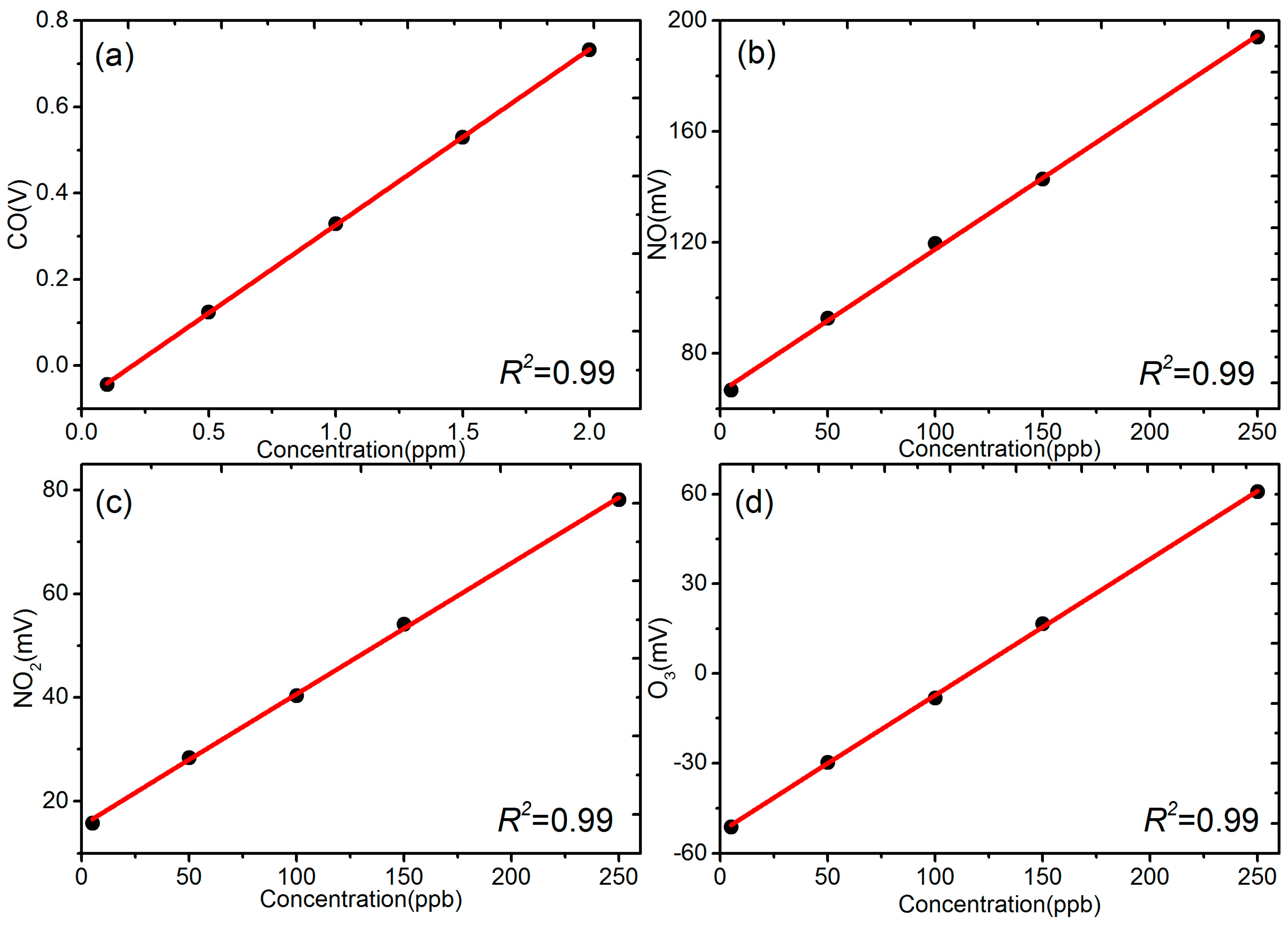

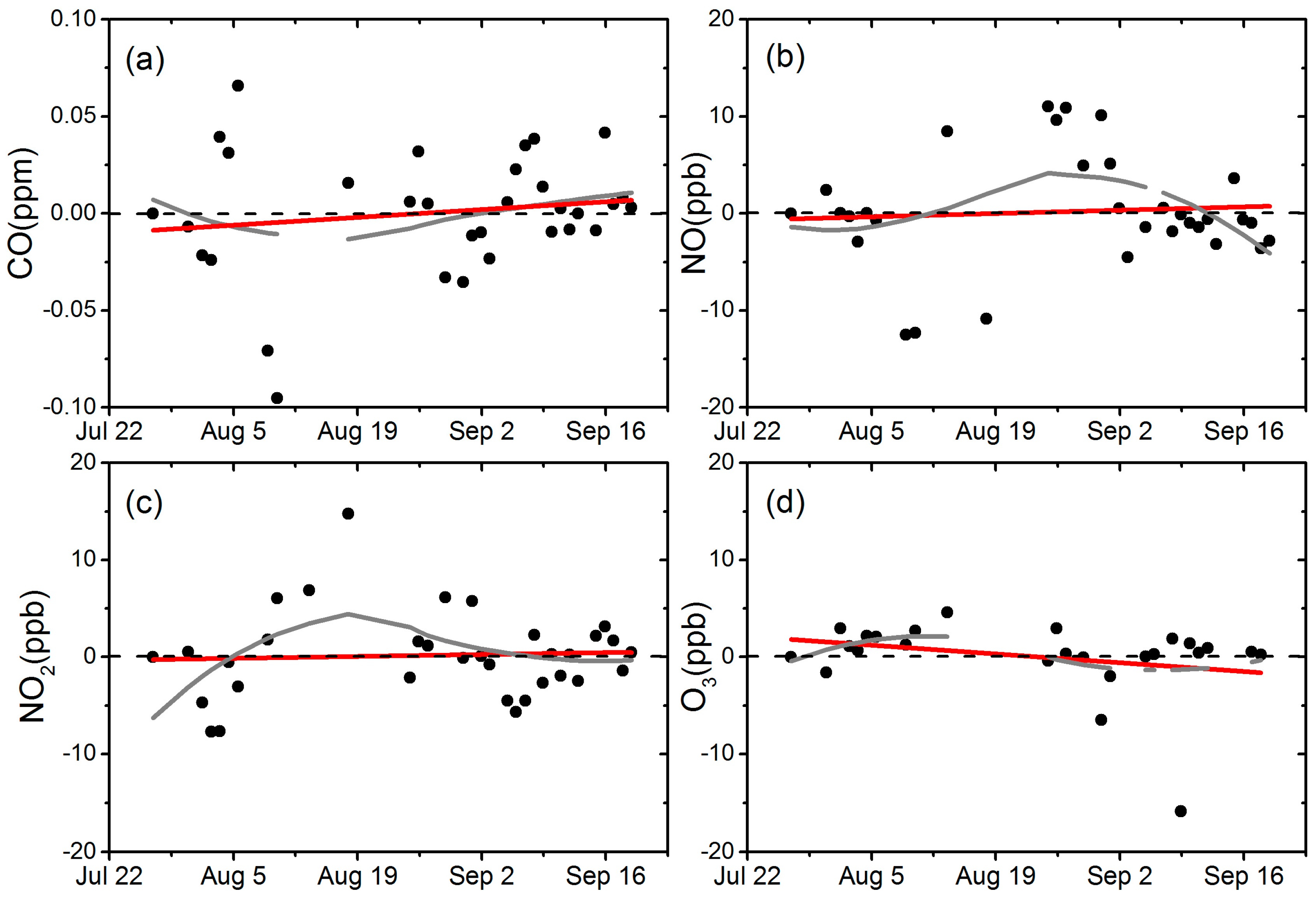

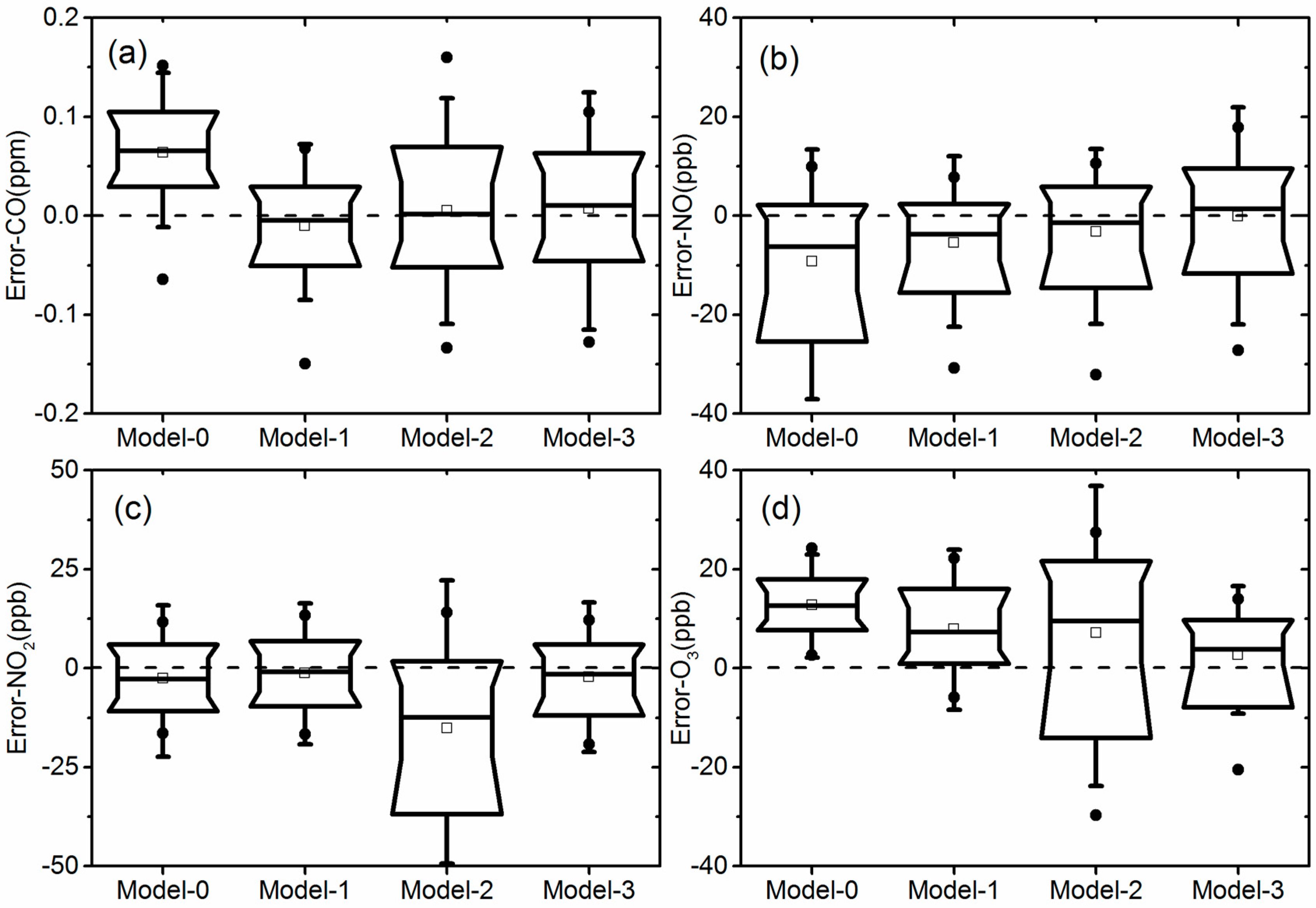
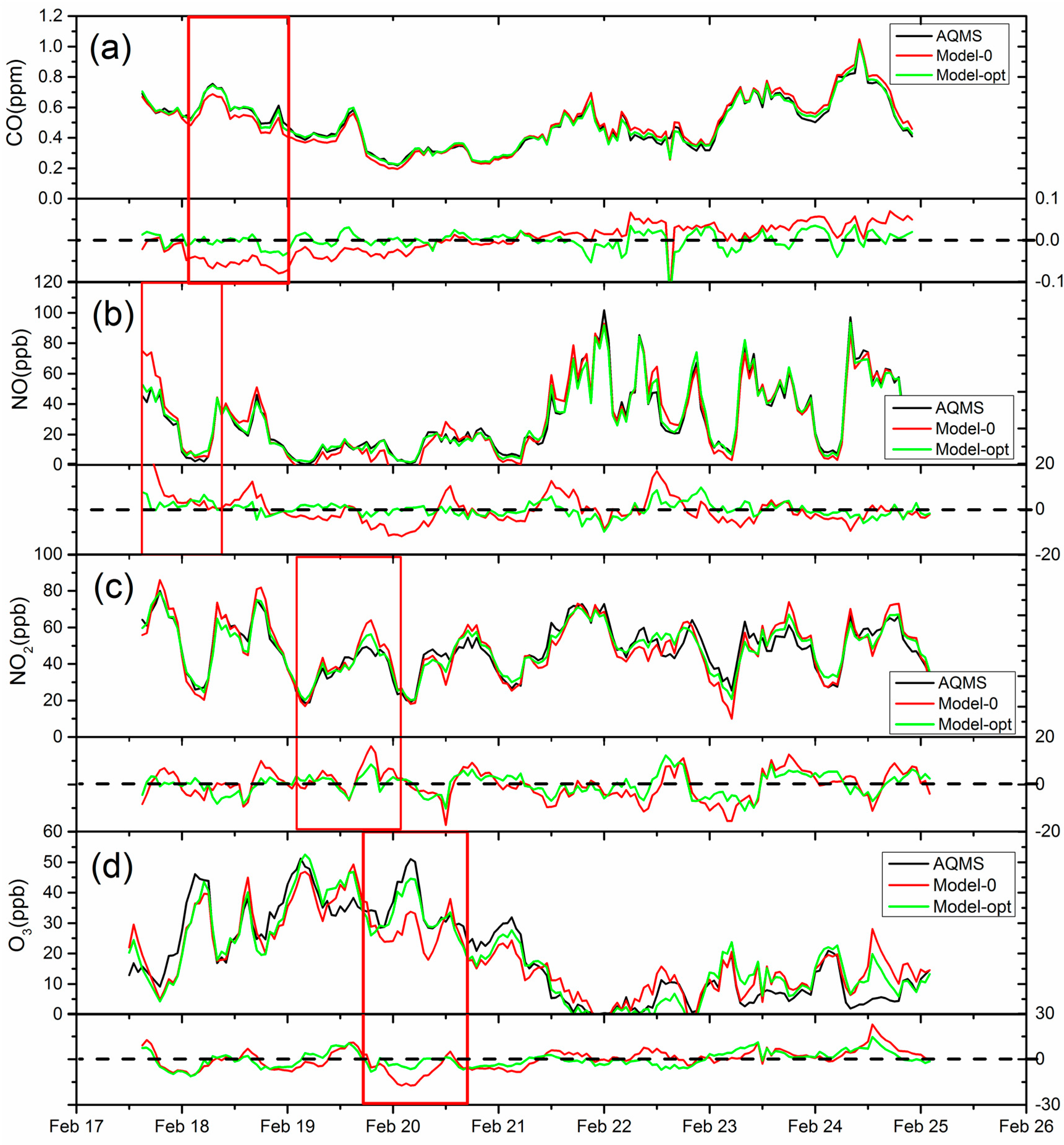

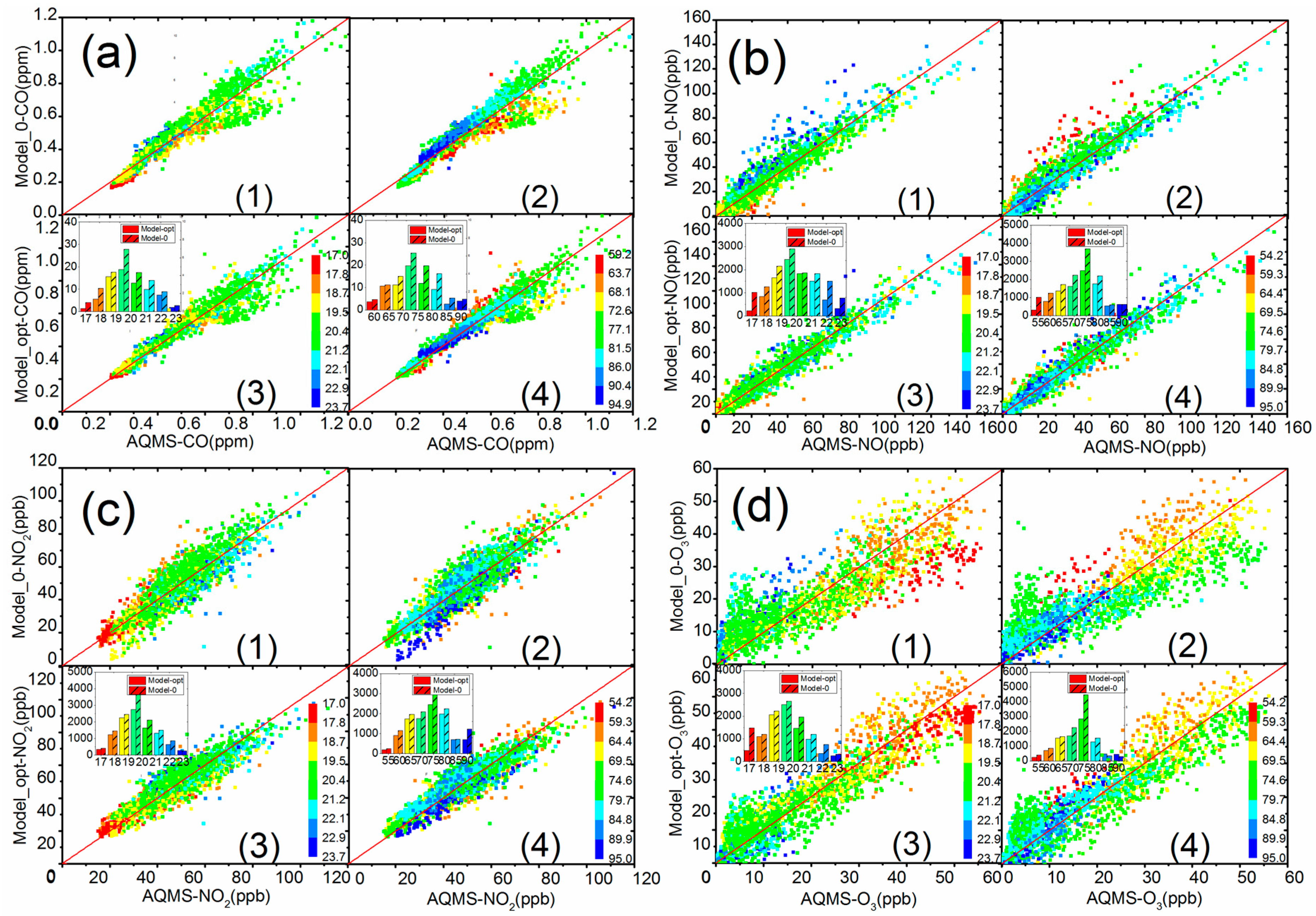
| Sensor | CO-B4 | NO-B4 | NO2-B4 | OX-B4 |
|---|---|---|---|---|
| R2 | 0.35 | 0.94 | 0.56 | 0.45 |
| T-weight (m V/°C) | −1.28 | 3.16 | −1.15 | −0.38 |
| RH-weight (m V/%) | 1.12 | 0.03 | −0.70 | −0.67 |
| Gas | Sensor | ||||
|---|---|---|---|---|---|
| CO-B4 | NO-B4 | NO2-B4 | Ox-B4 | ||
| CO @1 ppm | NA | <1% | <1% | <1% | |
| NO @100 ppb | <1% | NA | <1% | <1% | |
| NO2 @100 ppb | <1% | <1% | NA | 100% | |
| O3 @100 ppb | <1% | <1% | <1% | NA | |
| Sensor | CO-B4 | NO-B4 | NO2-B4 | O3-B4 | ||||||||||||
|---|---|---|---|---|---|---|---|---|---|---|---|---|---|---|---|---|
| Calibration | Validation | Calibration | Validation | Calibration | Validation | Calibration | Validation | |||||||||
| 1σ | R2 | 1σ | Mean | 1σ | R2 | 1σ | Mean | 1σ | R2 | 1σ | Mean | 1σ | R2 | 1σ | Mean | |
| (ppm) | (ppm) | (ppm) | (ppb) | (ppb) | (ppb) | (ppb) | (ppb) | (ppb) | (ppb) | (ppb) | (ppb) | |||||
| Model 0 | 0.03 | 0.96 | 0.050 | 0.06 | 6.4 | 0.82 | 11.6 | −9.2 | 6.5 | 0.84 | 6.6 | −2.6 | 5.8 | 0.70 | 4.5 | 12.7 |
| Model 1 | 0.02 | 0.98 | 0.046 | −0.01 | 5.4 | 0.87 | 7.8 | −5.5 | 5.8 | 0.79 | 6.5 | −1.2 | 5.4 | 0.73 | 6.1 | 7.9 |
| Model 2 | 0.03 | 0.97 | 0.061 | 0.01 | 5.3 | 0.87 | 8.7 | −3.2 | 7.5 | 0.87 | 15.9 | −15.2 | 5.5 | 0.73 | 13.4 | 7.2 |
| Model 3 | 0.02 | 0.98 | 0.057 | 0.01 | 5.4 | 0.87 | 8.9 | 1.4 | 5.8 | 0.87 | 7.0 | −2.3 | 5.6 | 0.72 | 7.0 | 2.7 |
© 2018 by the authors. Licensee MDPI, Basel, Switzerland. This article is an open access article distributed under the terms and conditions of the Creative Commons Attribution (CC BY) license (http://creativecommons.org/licenses/by/4.0/).
Share and Cite
Wei, P.; Ning, Z.; Ye, S.; Sun, L.; Yang, F.; Wong, K.C.; Westerdahl, D.; Louie, P.K.K. Impact Analysis of Temperature and Humidity Conditions on Electrochemical Sensor Response in Ambient Air Quality Monitoring. Sensors 2018, 18, 59. https://doi.org/10.3390/s18020059
Wei P, Ning Z, Ye S, Sun L, Yang F, Wong KC, Westerdahl D, Louie PKK. Impact Analysis of Temperature and Humidity Conditions on Electrochemical Sensor Response in Ambient Air Quality Monitoring. Sensors. 2018; 18(2):59. https://doi.org/10.3390/s18020059
Chicago/Turabian StyleWei, Peng, Zhi Ning, Sheng Ye, Li Sun, Fenhuan Yang, Ka Chun Wong, Dane Westerdahl, and Peter K. K. Louie. 2018. "Impact Analysis of Temperature and Humidity Conditions on Electrochemical Sensor Response in Ambient Air Quality Monitoring" Sensors 18, no. 2: 59. https://doi.org/10.3390/s18020059




